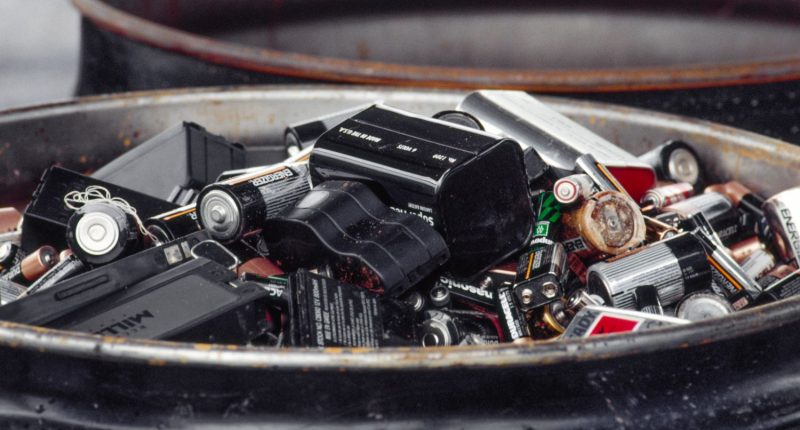By Tayo Olayinka
Lithium-ion batteries are found in most devices used today, including electric cars (EVs). With the growth in the market for lithium-ion batteries comes the concern of how to recycle or dispose of them sustainably. Used improperly, lithium-ion batteries pose a threat because they contain harmful chemicals that could cause safety and environmental hazards.
For Canadian lithium stock investors, understanding the recycling process is an ethical responsibility and an investment opportunity as the market for lithium recycling grows. This article will explore the best methods for recycling and disposing of used lithium batteries while highlighting the importance of proper battery management. Read on to learn more.
Why is it important to recycle lithium batteries?
Lithium-ion batteries contain valuable materials such as lithium, cobalt, nickel, and other metals that can be reclaimed and reused. Recycling used batteries can recover these finite resources, reduce the need for new mining projects and minimize the environmental impact. Moreover, lithium batteries are considered hazardous waste because they can release toxic chemicals and heavy metals into the environment if thrown into landfills.
Improper disposal can lead to battery fires and contamination of soil and water. Given the rise in electronic devices and EVs, improperly handling used lithium batteries can lead to larger environmental issues. Recycling is crucial in reducing the strain on natural resources and reducing the adverse effects of mining.
For Canadian investors, the growing focus on recycling aligns with the global push towards sustainability and green energy. Companies that invest in lithium recycling technologies are well-positioned to benefit from this emerging market, and investors should pay close attention to this trend.
Common types of lithium batteries and their disposal
Before diving into recycling methods, it’s important to understand the types of lithium-ion batteries used today. The most common types are:
- Lithium-Ion (Li-ion): Found in smartphones, laptops and electric vehicles. These are rechargeable and contain high energy density.
- Lithium iron phosphate (LFP): Commonly used in electric buses and energy storage systems.
- Lithium polymer (LiPo): These batteries are used in drones, remote control cars and various consumer electronics.
Each type of lithium battery has its own disposal and recycling method, but the guiding principles remain the same. Don’t toss them in the trash; always opt for recycling through authorized programs.
How to safely dispose of used lithium batteries?
Disposing of lithium batteries requires caution, as improper handling can result in safety hazards. Follow these steps to dispose of used lithium batteries safely:
- Store batteries properly: If you are not immediately recycling them, store the used batteries in a cool, dry place. Avoid keeping them in hot or humid areas, which can cause leaks or fires.
- Tape the terminals: Before transporting or storing the batteries, tape the terminals with non-conductive (such as electrical) tape to prevent short-circuiting, which could lead to fires.
- Check with local guidelines: Municipalities in Canada often provide guidelines or services for safe disposal. Inquire about e-waste collection days or battery drop-off points at local recycling centres.
- Never throw in regular garbage: Lithium batteries are classified as hazardous and should never be tossed into regular household waste. Doing so increases the risk of fire and environmental contamination.
- Use authorized collection points: Retail stores, electronics manufacturers, and battery recyclers across Canada often offer free battery recycling services. Organizations such as Call2Recycle provide a searchable directory of collection sites across the country. This makes it easy for consumers to locate a drop-off point nearby.
Recycling lithium batteries
Recycling lithium batteries involves a process designed to reclaim valuable materials and prevent environmental harm. Here’s a simplified version of how the recycling process works:
- Collection: Used lithium batteries are gathered through recycling programs, drop-off sites, and e-waste collection events. In Canada, retailers such as Best Buy, Staples and many auto shops offer battery recycling programs.
- Sorting: Batteries are sorted based on their chemistry – lithium-ion, lithium-polymer, etc. This step is crucial to ensuring proper processing and safety.
- Shredding and Separation: Batteries are then shredded, and the materials inside, such as lithium, cobalt and nickel, are separated. Techniques such as pyrometallurgical (high heat) and hydrometallurgical (using chemicals) extract valuable metals.
- Purification: Extracted materials are purified for reuse. These recovered metals can produce new batteries, reducing the need for virgin mining resources.
- Reuse: Once purified, lithium and other materials are reused to manufacture new batteries, closing the loop in a circular economy. This reduces the environmental impact of mining and helps meet the increasing demand for battery materials.
Several companies such as Li-Cycle have pioneered innovative lithium battery recycling technologies in Canada. Li-Cycle’s “spoke and hub” technology allows the company to recover up to 95 per cent of the materials from spent batteries. It makes them a leader in sustainable recycling practices. Investors should watch companies at the forefront of recycling technologies as they represent promising opportunities in the green energy sector.
The future of lithium recycling in Canada
Canada is uniquely positioned to become a global leader in lithium recycling. It is because of its strong infrastructure, access to raw materials and commitment to environmental sustainability. With the growing push for electric vehicles and renewable energy storage solutions, the demand for recycled lithium will continue to rise.
As a result, many companies are investing in research and development to improve the efficiency of lithium recycling. Advances in technology could allow more batteries to be recycled and reduce the reliance on traditional mining methods. For investors, this shift offers a potential windfall. Companies that develop and implement advanced recycling techniques could see significant growth as demand increases.
The federal government has also recognized the importance of lithium recycling and is encouraging innovation through various grants and incentives. Investors should pay attention to policy changes that promote sustainable practices in the energy sector, as these may impact stock prices.
What Canadian penny stock investors should know?
For penny stock investors, the lithium recycling market presents exciting opportunities. The increasing number of batteries in use and the subsequent need for proper disposal mean that companies specializing in recycling will be in high demand. Investing in companies that focus on sustainability and battery recycling aligns with global environmental goals and offers financial potential.
The stock of companies involved in lithium battery recycling is worth considering. Especially as the demand for electric vehicles, renewable energy and electronics continues to soar. Investors should monitor companies such as Li-Cycle (NYSE:LICY) and other Canadian leaders in battery recycling for future growth.
Conclusion
Recycling and disposing of used lithium batteries responsibly is essential for protecting the environment and reducing the need for raw material extraction. As lithium-ion battery use continues to grow, proper recycling methods will play a critical role in minimizing the environmental footprint of modern technology. For Canadian penny stock investors, this presents an exciting opportunity to invest in the future of green energy and sustainability.
By supporting companies involved in lithium recycling, investors can contribute to a cleaner environment while capitalizing on the expanding demand for lithium-based technologies. Keep an eye on the evolving battery recycling market – it’s a growing and vital market to our planet’s sustainable future.
Join the discussion: Find out what everybody’s saying about lithium stocks on the Bullboards, and check out the rest of Stockhouse’s stock forums and message boards.
The material provided in this article is for information only and should not be treated as investment advice. For full disclaimer information, please click here.
(Top photo of a 55-gallon drum filled with household batteries: Adobe Stock)







